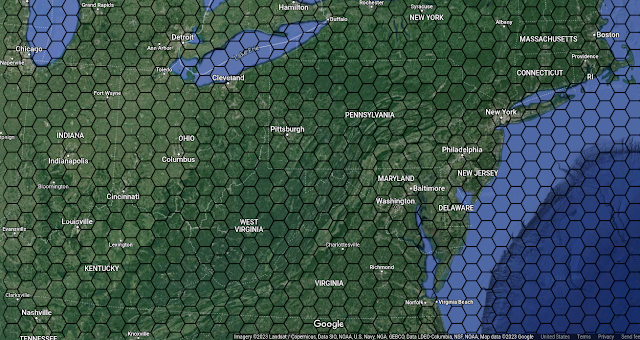I'm considering doing some mapping on 24-mile hex scales, and wanted to get a sense of just how big that was. Previously I had imposed a ~24-mile hex grid over parts of France, but that doesn't really tell me much. But the same technique was easy to apply to more familiar country:
One could reach most of these same conclusions from just looking at numbers - distances between cities, areas of states. But it's still interesting.
Pennsylvania is something like 85 or 90 24-mile hexes - enough area to be a Kingdom by ACKS' standards.
Massachusetts is maybe 16 hexes, somewhere in the large duchy to small principality range. The projection might be messing with this a bit, I think taking MA's land area and dividing it by the area of a 24-mile hex I get closer to 20 hexes.
Lake Erie is something like 16 24-mile hexes - enough area to be a merfolk duchy.
Even Rhode Island is good hex or two (or three by the numbers).
It's only about four hexes from DC to Richmond - about a week encumbered on foot at 60' speed or with a cart with plenty of draft animals.
Megacity Ruin Hexes
New York City proper basically occupies a whole 24-mile hex; it's 32 miles from Yonkers to the southwestern tip of Staten Island, 25 miles from that tip of Staten Island to JFK airport, and 18 miles from JFK to Yonkers. And that's ignoring Newark and most of Long Island. Washington DC proper is 70 square miles (about two full 6-mile hexes) and is maybe a 6th of the DC metro area. The DC beltway and the ring-road around Boston both have radii of about 10 miles, and there's plenty of 'burbs outside those rings. In a post-apocalyptic setting, one could readily fill an entire 24-mile hex with terrain type "ruined city" and it wouldn't be crazy.
Culture Distances
New York City is 13 hexes by land to Richmond or 14 by sea to Norfolk, and 14 hexes by sea or 8 by land to Boston - and those were distances great enough for significantly different cultures, accents, and modes of life to emerge and persist for a long time, even starting from a shared language. This checks out if you look at France too - Paris to the middle of Brittany (which was unified with the French crown in 1532 but where only half of the population spoke French in 1900) is about 10 hexes, and Paris to Zurich is about 12 hexes. From the southwestern tip of Flanders to the northeastern end of the Netherlands, the whole region where Dutch is the primary language, is only about 240 miles - 10 hexes.
Philadelphia to Pittsburgh is 11 hexes across a mountain range, well up into that "cultural divergence" distance. Hence the Westsylvania movement. Pittsburgh to Chicago is another 19 hexes - enough distance for at least one complete divergent regional culture (and likely a dialect if not a whole new language) in between them.
This 10-hex cultural divergence distance is also interesting from the perspective of kings of people, not of places - if every 10 hexes or so of forest and hills you have a culture shift, then the natural size for a kingdom of a people, of a culture, is about 10 hexes by 10 hexes of such terrain. Which is on the low side for a kingdom in ACKS, but it's in the right range. It's possible I've accidentally picked odd boundary situations (though I'm not aware of a big natural barrier between Brittany and Paris...). At this size, you can march your army from one side of the kingdom to the other and back in about two months. "Two weeks from the center to the border" might be a reasonable heuristic. Beyond that you start getting into empire - you can conquer them and extract tribute, but they'll retain their own culture for a long time (longer than the campaign will run, in any case).
These numbers are also kind of in the right ballpark for a couple of other thing sin ACKS. A kingdom in ACKS tends to have a single Class II market city, which has a trade range by road of 144 miles (6 24-mile hexes), which is a little short but means that the whole trade range (by road) is probably within the kingdom if the city is centrally located. These sort of 10-hex distances are also towards the outer limit for supplying your army from a centrally-located capital city in Domains at War: Campaigns without having forward supply bases, too - the base range is 96 miles (4 24-mile hexes), but this is multiplied by 4 on roads or by 3 through "settled" territory. Assuming a ring of settlement around the central market and then diminishing population density and road construction at the frontiers, we might reasonably expect to get x3 supply chain length for a good portion of the way but then logistics break down at the edge and we end up a little short of x3 overall. So it's the area you can definitely project power into with no prep.
... it's about 290 miles from London to Dublin as the crow flies and that's sure a culture-border that has persisted over centuries. London to the south edge of Scotland is about 275 miles by land, 11 hexes. London to the edge of Cornwall is only about 7 hexes and the Cornovii have mostly lost their own language (though it took a thousand years from when the Saxons arrived) and have a dialect of English, while London to the edge of Wales is a mere 6 hexes - but there's some rough country in Wales, and the English language didn't start making inroads into Wales until the Industrial Revolution, which is well after the period we're interested in modeling cultural dynamics for.
(I eagerly await corrections from my readers in the UK)
I don't really have a good theory of these sort of culture-distances along nautical routes yet.
Nautical Matters
At 72 miles per day (three hexes), it would be four days by sail from NYC to either Norfolk or Boston with favorable winds. Those numbers don't seem totally crazy - the Everglades Challenge is a motorless small craft race from Tampa to Key Largo, which is 275 or 300 miles (11-12 hexes) or so, and the winning time in 2013 (which mostly had a favorable wind out of the north) was around two days of near-constant sail with very little sleep.
The continental shelf is also interesting, 2-4 hexes of shallow ocean off of the coast before the bottom drops off and it gets deeeep. It might be merciful to have separate encounter tables for littoral vs pelagic ocean with different weights for dragon turtles.


No comments:
Post a Comment